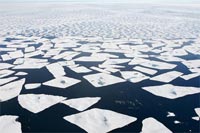Arctic region now warmest in 2000 years, researchers say
Long-term climate records from the Arctic provide strong new evidence that human-caused global warming can override Earth's natural heating and cooling cycles, U.S. researchers reported this week in the journal Science.

For more than 2,000 years, a natural wobble in Earth's axis has caused the Arctic region to move farther away from the sun during the region's summer, reducing the amount of solar radiation it receives. The Arctic is now 600,000 miles farther from the sun than it was in AD 1, and temperatures there should have fallen a little more than 1 degree Fahrenheit since then.
Instead, the region has warmed 2.2 degrees since 1900 alone, and the decade from 1998 to 2008 was the warmest in two millenniums, according to a team headed by climatologist Darrell S. Kaufman of Northern Arizona University.
Not only was the last half-century the warmest of the last 2,000 years, "but it reversed the long-term, millennial-scale trend toward cooler temperatures," Kaufman said , reports Los Angeles Times.
According to Time, another study released this week by the World Wildlife Fund (WWF) examines that problem and its potential future effects — and it's not pretty. The WWF researchers found that Arctic sea ice is melting at a faster rate than expected, and that the massive land sheets in Greenland and parts of Antarctic are vulnerable.
The report predicts that global sea level will rise more than 3 ft. by 2100, significantly higher than scientists had previously believed. "What we're finding is truly sobering," says Martin Sommerkorn, the senior adviser for the WWF's Arctic Program.
"I think it really underscores how sensitive the Arctic is to climate change ... and it's really the place where you can see first what's happening to the (climate) system and how the rest of the Earth will or might follow," David Schneider, a co-author and a scientist with the U.S. National Center for Atmospheric Research said in a telephone interview, Reuters informs.
Subscribe to Pravda.Ru Telegram channel, Facebook, RSS!





